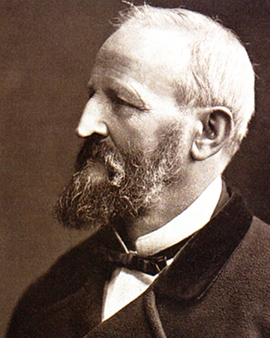Karl Bodmer was a Swiss-French etcher, lithographer, draughtsman and painter. He came from Zurich. At the age of thirteen, Bodmer began training as an etcher, lithographer and engraver in his uncle's business. In 1825 he became self-employed with his brother as an engraver.
In 1828 Bodmer moved to Koblenz to produce etchings and paintings for tourists. He quickly made a good name for himself with his pictures of landscapes along the Rhine, Moselle and Lahn. Eventually, the explorer Prince Maximilian zu Wied-Neuwied became aware of him, who was planning an expedition to the North American Indian territories. For this purpose he engaged Bodmer, who was to document the journey in pictures and as much detail as possible.
In May 1832 the group set sail and reached Boston on 4 July. The American East was suffering from a cholera epidemic. The expedition left Boston and reached New Harmony in Indiana, where the cholera caught up with them in late October. The Prince and other travellers fell ill. Bodmer therefore continued the journey alone at first; he reached New Orleans. After her recovery, the Prince and the rest of the group also continued their journey. By mid-March 1833, the expedition was reunited and continued on its way west. During their journey they met and documented numerous Indian peoples. Bodmer was later to say that he had found acquaintances among the Europeans but friends among the Indians. He didn't want to return to Europe at all, but wanted to stay with the Indians, but Prince Max was finally able to persuade him to return. In mid-July 1834 they embarked from New York to Le Havre, where they arrived at the beginning of August. They had been travelling for over two years.
Back in Europe, they returned to Germany. In 1835, Bodmer moved to Paris. He had brought over 400 pictures with him from the USA, whose conversion into engravings he had to supervise. This work took years; the Prince's travelogue, with illustrations by Bodmer, first appeared in 1839, five years after the end of the expedition. In 1848 Bodmer moved to Barbizon because of the February Revolution and also because of a cholera epidemic. He took French citizenship and continued his artistic work in various techniques. In 1884 Bodmer returned to Paris, sick and impoverished. Deaf and blind, he died there in 1893.
×





 - (MeisterDrucke-165322).jpg)
 - (MeisterDrucke-165322).jpg)
.jpg)
.jpg)
.jpg)
.jpg)
.jpg)
.jpg)
.jpg)
.jpg)
.jpg)
.jpg)
.jpg)
.jpg)
.jpg)
.jpg)
 - (MeisterDrucke-307394).jpg)
 - (MeisterDrucke-307394).jpg)
_-_(MeisterDrucke-248547).jpg)
_-_(MeisterDrucke-248547).jpg)
.jpg)
.jpg)
.jpg)
.jpg)
.jpg)
.jpg)
.jpg)
.jpg)
 - (MeisterDrucke-649716).jpg)
 - (MeisterDrucke-649716).jpg)
.jpg)
.jpg)
.jpg)
.jpg)
.jpg)
.jpg)
 (see 29098 for detail) - (MeisterDrucke-166085).jpg)
 (see 29098 for detail) - (MeisterDrucke-166085).jpg)
.jpg)
.jpg)
.jpg)
.jpg)
.jpg)
.jpg)
.jpg)
.jpg)
.jpg)
.jpg)
 - (MeisterDrucke-152441).jpg)
 - (MeisterDrucke-152441).jpg)
.jpg)
.jpg)
.jpg)
.jpg)
 and J Hurlimann 1843 (aquatint) - (MeisterDrucke-195091).jpg)
 and J Hurlimann 1843 (aquatint) - (MeisterDrucke-195091).jpg)
.jpg)
.jpg)
.jpg)
.jpg)
.jpg)
.jpg)
.jpg)
.jpg)
.jpg)
.jpg)
.jpg)
.jpg)
_-_(MeisterDrucke-38128).jpg)
_-_(MeisterDrucke-38128).jpg)
.jpg)
.jpg)
.jpg)
.jpg)
.jpg)
.jpg)
.jpg)
.jpg)
.jpg)
.jpg)
_and_Karl_Bodmer_are_greeted_by_the_Hidat_-_(MeisterDrucke-1083737).jpg)
_and_Karl_Bodmer_are_greeted_by_the_Hidat_-_(MeisterDrucke-1083737).jpg)
.jpg)
.jpg)
.jpg)
.jpg)
.jpg)
.jpg)
.jpg)
.jpg)
.jpg)
.jpg)
_-_(MeisterDrucke-1369824).jpg)
_-_(MeisterDrucke-1369824).jpg)
.jpg)
.jpg)
.jpg)
.jpg)
.jpg)
.jpg)
_-_(MeisterDrucke-1370783).jpg)
_-_(MeisterDrucke-1370783).jpg)
.jpg)
.jpg)
.jpg)
.jpg)
 on the Missouri plate 6 from Volume 2 o - (MeisterDrucke-231795).jpg)
 on the Missouri plate 6 from Volume 2 o - (MeisterDrucke-231795).jpg)
.jpg)
.jpg)
.jpg)
.jpg)
 - (MeisterDrucke-150658).jpg)
 - (MeisterDrucke-150658).jpg)
.jpg)
.jpg)
.jpg)
.jpg)
.jpg)
.jpg)
.jpg)
.jpg)
 - (MeisterDrucke-292953).jpg)
 - (MeisterDrucke-292953).jpg)
.jpg)
.jpg)
 - (MeisterDrucke-185909).jpg)
 - (MeisterDrucke-185909).jpg)
.jpg)
.jpg)
.jpg)
.jpg)
.jpg)
.jpg)
.jpg)
.jpg)
.jpg)
.jpg)
.jpg)
.jpg)
.jpg)
.jpg)
.jpg)
.jpg)
.jpg)
.jpg)
.jpg)
.jpg)
.jpg)
.jpg)
.jpg)
.jpg)
.jpg)
.jpg)
 - (MeisterDrucke-648756).jpg)
 - (MeisterDrucke-648756).jpg)
.jpg)
.jpg)
.jpg)
.jpg)
.jpg)
.jpg)
.jpg)
.jpg)
_-_(MeisterDrucke-1380498).jpg)
_-_(MeisterDrucke-1380498).jpg)
.jpg)
.jpg)
.jpg)
.jpg)
.jpg)
.jpg)
.jpg)
.jpg)
 - (MeisterDrucke-175996).jpg)
 - (MeisterDrucke-175996).jpg)
.jpg)
.jpg)
.jpg)
.jpg)
.jpg)
.jpg)
.jpg)
.jpg)
.jpg)
.jpg)
.jpg)
.jpg)
.jpg)
.jpg)
.jpg)
.jpg)
.jpg)
.jpg)
.jpg)
.jpg)
 - (MeisterDrucke-181957).jpg)
 - (MeisterDrucke-181957).jpg)
.jpg)
.jpg)






